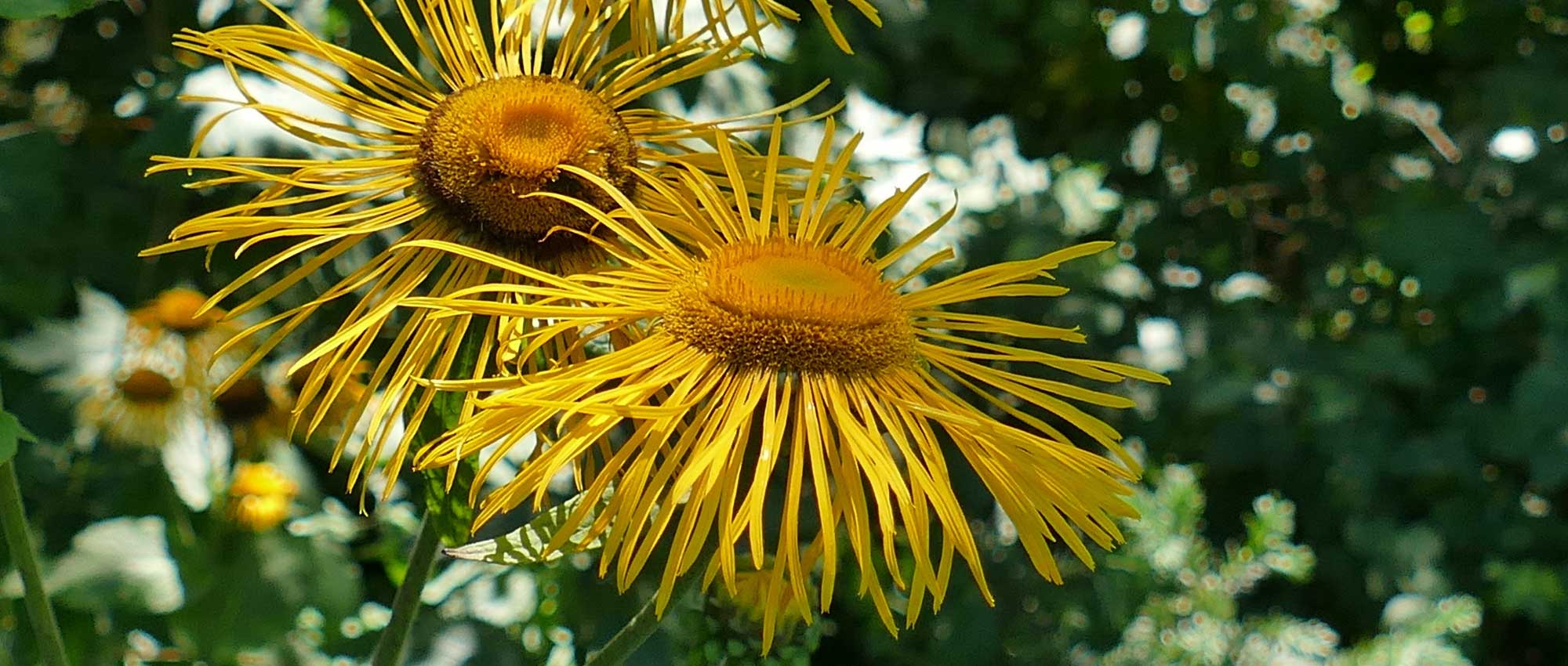
Inula, elecampane: planting, growing and care
Contents
Inula in a nutshell
- Inula is appreciated for its summer flowering in large, golden-yellow heads that are very bright!
- It is a large, imposing plant with an erect habit, reaching up to 2 m tall
- Its root is edible and has medicinal properties
- A robust, vigorous plant, hardy and largely resistant to disease
- Perfect as a backdrop in perennial beds, alongside other colourful flowering plants
A word from our Expert
Inula, or elecampane, is a large plant, generally perennial, with an upright habit, and which produces in mid-summer yellow flower heads! The shape of the flowers is reminiscent of daisies or asters. The best-known species is Inula helenium, or great elecampane, a robust, vigorous plant that can reach 2 m in height! But other species remain smaller, such as Inula ensifolia, a delicate plant with fine foliage and a rounded habit.
In addition to its ornamental interest, Inula helenium is particularly valued for its medicinal properties, notably against breathing ailments. Its root is used, usually as an infusion or decoction.
Inula fits very well into mixed borders, in association with other perennials. It brings both volume and brightness to borders! It also finds its place in wild, natural-style gardens, as well as in medicinal plant gardens. Finally, smaller species can be planted in rockery.
Inula helenium thrives in good garden soil, fertile and fresh. Once established, it is fairly easy to maintain. Simply water during dry periods so soil remains relatively fresh, and cut young plants back to soil level in autumn. We also recommend dividing them every three to four years to rejuvenate clumps.
Description and botany
Botanical data
- Latin name Inula sp.
- Family Asteraceae
- Common name Inula, elecampane
- Flowering generally in July–August
- Height between 25 cm and 2.5 m
- Exposure sun or partial shade
- Soil type fresh, deep, rich, rather calcareous
- Hardiness between -15 and -20 °C
Inula include 110 species of plants, generally perennial, but which can also be annual or biennial. They originate from Europe, Asia and Africa. Most species come from Central Asia, with some occurring as far as the Himalayas. Cultivated for a long time for medicinal properties, Inula helenium has naturalized in several regions of the world, notably in North America and Europe.
In France, nine species occur in the wild, including Inula helenium. Inula can be found in fields, meadows, roadsides, fallow land or uncultivated places. Inula helenium prefers fresh, partially shaded sites (woodland edges, hedgerows, damp meadows…), while other species favour rocky, drier ground.
Inula belongs to large family Asteraceae (almost 33,000 species), like daisies, ox-eye daisies or sunflowers. Main characteristic of this family is presence of flowers gathered in heads. Individual flowers are tiny, but gathered in great numbers to form a kind of disc, a head, resembling a single large flower.
Genus Dittrichia is very close to Inula, since two species formerly considered Inula have been renamed Dittrichia (Dittrichia graveolens and Dittrichia viscosa).

Inula helenium: botanical illustration
Name Inula may derive from Greek enàein: to purge, to purify, alluding to medicinal properties of the plant. Specific name helenium refers to Helen, daughter of Zeus in Greek mythology, who was abducted by Paris, triggering Trojan War. According to legend, plant grew where her tears fell to ground… Or, according to other sources, Helen was gathering this plant at moment of her abduction.
Inula helenium is an imposing perennial with woody stump. It is vigorous and robust, fairly hardy, and grows quickly. It has a rather rigid habit, with large downy, hairy and fairly thick stems. These stems are ramified at the top. There is, however, a stemless species: Inula rhizocephala, which forms rosettes at ground level and produces flowers at centre of rosette.
The size of Inula therefore varies greatly by species, since they measure between 25 cm and 2.5 m in height. Inula ensifolia is among smallest, while Inula helenium and Inula racemosa are the tallest. Inula helenium can reach 2 m in height… hence common name great elecampane.
Inula flowers in midsummer, generally in July–August (but, depending on variety, flowering can occur between June and October). Inula then bears, at tops of upright stems, large golden-yellow heads. They are valued for their bright colour. Heads can be solitary or grouped in corymbs.
What appears to be a single flower is in fact a multitude of tiny flowers, gathered on same plane, exactly like daisies, ox-eye daisies or asters. This particular inflorescence is called a head. It is composed of tubular flowers at centre and ligulate flowers at periphery, on the outside. Ligulate flowers are particularly long and slender, narrow. They give head a more or less “ruffled”, untidy aspect. They radiate around centre of head. They are lighter, a brighter yellow, than tubular flowers at centre of head. Latter are dark yellow, sometimes a little brownish. Ligules are female flowers, while tubular flowers are hermaphrodite (bearing stamens and pistil). Around base of head one can see bracts, overlapping in several ranks.
Heads of Inula helenium are fairly large, measuring between 5 and 8 cm in diameter, while in Inula ensifolia they do not exceed 3 cm in diameter. Inula viscosa also has fairly small flowers, more closely arranged along stems.
Inula is a good melliferous plant; its flowers attract insects that visit to pollinate them.

Cross-section of a head of Inula ensifolia (photo Stefan Lefnaer): tubular flowers at centre and ligulate flowers on outside / Head of Inula magnifica / Flowering of Inula helenium
Inula helenium forms a basal rosette of leaves, very large, and also bears cauline leaves on the stem. They become progressively smaller higher up the stem. Lower leaves are petiolate, while others are sessile, embracing stem. Cauline leaves are alternate, inserted one after another.
In general, Inula leaves are particularly large. Those of Inula helenium can reach 80 cm in length. They are ovate, quite broad, simple, not lobed. Margin of lamina is dentate. Foliage appears rather coarse, massive and imposing, not very fine, with a puckered, somewhat rough texture. Some species have much smaller leaves: in Inula ensifolia they do not exceed 10 cm in length, and are particularly fine, narrow, linear in shape. They have a delicate, graphic aspect.
Leaves are green, marked by white veins. Inula candida has white-grey, downy leaves with very soft appearance. Species Inula viscosa, by contrast, has sticky, viscous foliage.
In Inula helenium, leaves are green on upper surface but rather whitish beneath, as covered with hairs, felted. Central vein is prominent on underside of leaves.
Inula helenium is a deciduous plant: aerial parts die back in autumn and regrow in spring. Cutting plant back to ground level in autumn is recommended.

Large leaves of Inula helenium, those of Inula magnifica (photo Plenuska), and small linear leaves of Inula ensifolia (photo Krzysztof Ziarnek, Kenraiz)
Inula helenium has been recognised and cultivated since Antiquity for its medicinal root. Root is thick, fleshy and ramified. It is aromatic, and can be used to flavour desserts. It has a bitter taste and a camphor-like smell. It is sometimes used in production of absinthe.
Once Inula flowers have been fertilised, they give way to achenes of brown–reddish colour (dry fruit that does not open at ripeness and contains a single seed). These achenes are topped by egrets, which allow them to be carried by wind, just like dandelion seeds!
Inula tend to self-sow. If you want to avoid this, remove faded flowers before plant has time to produce seeds!
You can also choose to harvest seeds to try sowing and thus propagate your plants.
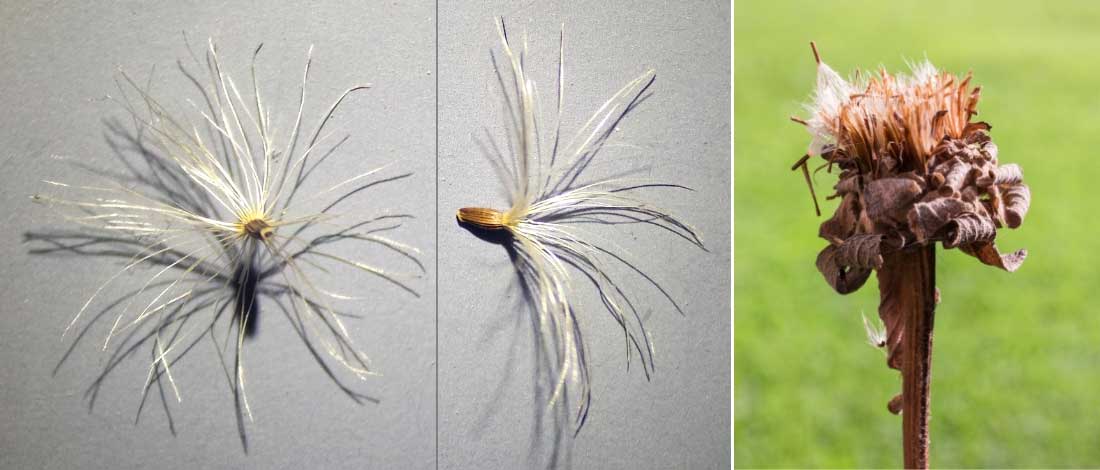
Detail of achenes of Inula ensifolia (photo Stefan Lefnaer) / Infructescence of Inula magnifica (photo Dominicus Johannes Bergsma)
Main varieties of Inula
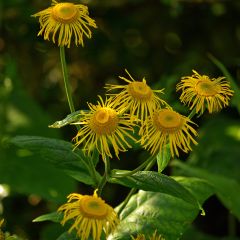
Inula magnifica
- Flowering time August to October
- Height at maturity 1,60 m
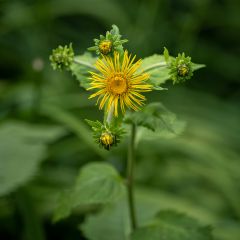
Inula racemosa Sonnenspeer - Indian elecampane
- Flowering time August to October
- Height at maturity 2,50 m
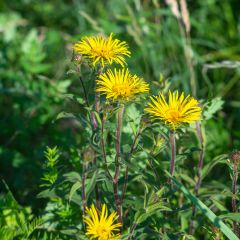
Inula ensifolia
- Flowering time July to September
- Height at maturity 30 cm
Discover other Inula
View all →Available in 1 sizes
Available in 1 sizes
Available in 1 sizes
Available in 1 sizes
Available in 1 sizes
Available in 1 sizes
Available in 1 sizes
Planting
Where to plant Inula?
You can plant Inula in full sun or partial shade. Exposure also depends on your location: if you live in the south of France, prefer a slightly shaded spot rather than full sun, whereas if you live north of the Loire, you can plant in full sun without problem.
Inula prefers soil rich in organic matter, fertile and deep. It also likes slightly calcareous soils. Soil should be relatively cool but well drained. Avoid heavy, compact soils that retain water. Overall, Inula are not very demanding and can adapt to different soil types.
Inula helenium fits very well into mixed borders, alongside other perennials that are summer-flowering. Even though pot planting is possible, it is preferable to plant Inula in the ground. Some species (the smaller ones, such as Inula ensifolia) adapt well to planting in rock gardens. Similarly, Inula viscosa thrives particularly in dry, sunny sites and is perfect for a rock garden or a dry garden.
Elecampane is a fairly large plant; give it plenty of space to develop. If possible, choose a sheltered position from wind. Otherwise, the taller species may need staking.
Given the height of some species (Inula helenium, Inula racemosa ‘Sonnenspeer’…), we suggest placing them towards the back of borders as a backdrop. Of course, if you grow smaller species such as Inula ensifolia, place them towards the front.
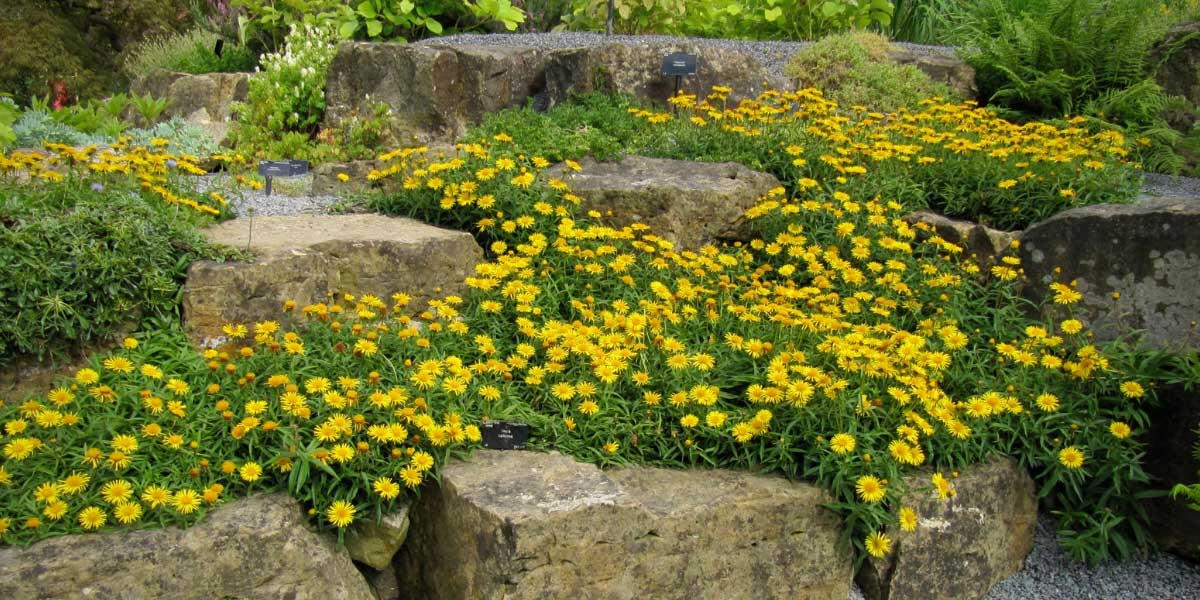
Some Inulas can be planted in rock gardens. Here, Inula salicina (photo Leonora Enking)
When to plant?
You can plant Inula in spring (April–May) or in autumn (September–October).
How to plant?
Planting distance varies by species, since they do not all reach the same size, but for Inula helenium we recommend at least 80–90 cm between two young plants.
- Start by placing the rootball in a basin filled with water so it can rehydrate.
- Choose the location for your plant, then dig a planting hole about twice the size of the rootball. We advise working the soil deeply to loosen it well and thus facilitate root establishment. Feel free to add some well-rotted compost to enrich the soil.
- Remove the plant from its pot.
- Place it in the planting hole, then fill in with soil around it and gently firm with the palm of your hand.
- Water thoroughly.
- Apply mulch around the plant to retain moisture and limit weed growth.
Care
Inula helenium prefers soils that remain relatively cool. Water occasionally during dry spells. We suggest applying a mulch, as this will keep soil cool for longer while enriching it with organic matter. Mulch also helps limit growth of weeds.
Inula helenium is a deciduous plant: its above-ground parts die back for winter. Carry out severe pruning in autumn, cutting plant back to ground level. It will restart growth in spring.
As it is a fairly tall plant, Inula may need staking to keep stems upright, especially if exposed to wind.
If you wish to avoid self-seeding, remove faded flowers.
As Inula favour fertile, organic-rich soils, they will appreciate an annual application, at the start of spring, of a little well-rotted compost.
If you wish to harvest Inula roots (for their medicinal and edible properties), do so in autumn, as this is when plant energy descends into the root system, before the plant enters dormancy for winter. Choose a young plant two or three years old.
Overall, Inula is not very susceptible to diseases and pests. However, it can be affected by powdery mildew, a fungal disease recognised by the appearance of a white coating on leaves. If you notice this disease, we recommend removing affected leaves, then spraying a sulphur-based solution or a horsetail decoction.
Multiplication
Inula is mainly propagated by division, but can also be sown.
Division of clumps
You can divide Inula clumps in early spring or autumn. We recommend doing this about every three years, as it rejuvenates plants and restores vigour.
Start by digging up the root system, digging wide enough not to damage it. If necessary, remove excess soil to make root system clearly visible. Cut roots into several sections using a sharp knife (they should be at least 5 cm long). Replant them either directly in the ground or initially in pots. You can also take the opportunity to collect some roots if you intend to use them for their medicinal properties.
Sowing
Inula produces achenes that you can harvest and then sow in spring or autumn under a cold frame. If growing conditions suit it, it may also self-seed in the garden.
- Prepare a pot with seed compost.
- Sow seeds by scattering them on the surface.
- Cover with a thin layer of substrate, then press down lightly.
- Water with a fine spray.
- Place pot under cover in a bright position but out of direct sun. For seeds to germinate, temperature must be at least 10 °C. Water regularly so substrate remains slightly moist.
- Prick out as soon as young seedlings reach a size that allows handling.
- You can plant them outdoors once temperatures become mild enough.
Expect flowering in the second year.
It is also possible to sow seeds directly in the ground in spring.
Companion planting
Inula are perfect for including in mixed borders, especially if you choose large species, such as Inula helenium or Inula racemosa, which are particularly imposing. Place them at the back of borders, and pair them with other summer-flowering perennial plants. Choose, for example, Achillea, Coreopsis, Anthemis tinctoria, campanulas, Echinacea, hardy geraniums, Penstemon, Phlox paniculata… Don’t forget the lightness of Gaura lindheimeri. And among all these flowers, don’t hesitate to include some ornamental grasses, such as Pennisetum, Calamagrostis or Stipa!
Compose a very colourful border by pairing Inula with other flowers in shades of yellow, orange and red…! Enjoy majestic flowering of daylilies, original spikes of kniphofias, or delicate flowers of Salvia microphylla. You can also choose Coreopsis, Gaillardia, Monarda, heleniums, dahlias, Achillea filipendulina… You will obtain a superb border in warm, vivid, blazing tones.
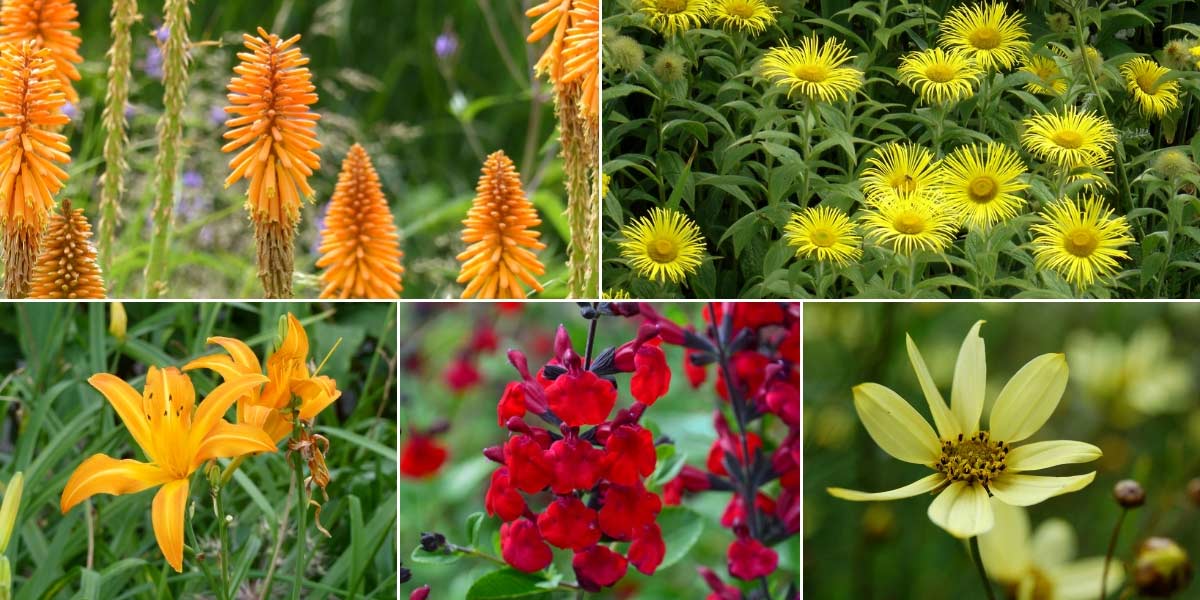
You can pair Inulas with other flowers in yellow – orange – red tones! Kniphofia ‘Fiery Fred’, Inula hookeri ‘Mude’ (photo Peganum), Hemerocallis aurantiaca ‘Gladys Perry’, Salvia ‘Rêve Rouge’ and Coreopsis verticillata ‘Moonbeam’
Because they have many benefits, you can use Inula to create a medicinal plant garden. Lay out a herb garden, including sages, marigolds, Achillea, mallow, hyssop, chamomile, agastache, common verbena… Also enjoy Arnica montana, whose yellow flowers will go very well with those of Inula! You can easily use this garden to harvest plants, dry them and use them in infusions. Also include some culinary herbs: thyme, lemon balm, lavender, mint, dill… which you can use in cooking.
Inula can also be included in a wild, country-style garden. Create a border with a relatively untidy appearance, using large plants with a free, airy habit. Choose a species such as Inula magnifica, and pair it with Achillea, Verbena hastata, sages, campanulas, Veronicastrum virginicum… Not forgetting ornamental grasses, essential for bringing a sense of ‘wild meadow’.
Smaller species can be used in rock gardens. Opt, for example, for Inula ensifolia or Inula candida, and plant them with rock geraniums, Delosperma cooperi, Campanula muralis, Dianthus deltoides, sedums and hens-and-chicks… Also enjoy the superb Convolvulus mauritanicus, which offers a delicate soft-blue flowering!
→ Discover more ideas to pair Inulas in our article!
Did you know?
- A medicinal and edible young plant!
Inula helenium has long been cultivated for its medicinal properties. It is the root that is used, mainly as a decoction or infusion. It is effective against cough and for relieving breathing ailments (bronchitis, cough…). It can also be used for digestive problems and to strengthen the immune system. Furthermore, it is antiseptic, vermifuge, tonic and diuretic. Roots are rich in inulin (it was in fact Inula that gave its name to this type of sugar).
The root of Inula is also edible, used to flavour desserts. It can be used fresh or dried. It helps stimulate appetite and promote digestion. It has a bitter flavour. Young leaves can also be eaten. Roots are harvested in autumn from young plants two or three years old.
Useful resources
-
- Discover our range of Inulas!
- Our article on caring for perennial plants
- Ourarticle : How to create a beautiful perennial border?
Frequently asked questions
-
Leaves of my Inula are covered with a white downy coating. Why?
It is probably affected by powdery mildew, a fungal disease caused by a fungus. At first a white powdery coating appears on the leaves, which then tend to become distorted and dry out. We recommend removing and burning affected leaves to limit its spread, then treating with a fungicide, for example sulphur or a horsetail decoction. Likewise, when watering, direct the jet to the base of the plant, taking care not to wet the foliage.
- Subscribe!
- Contents
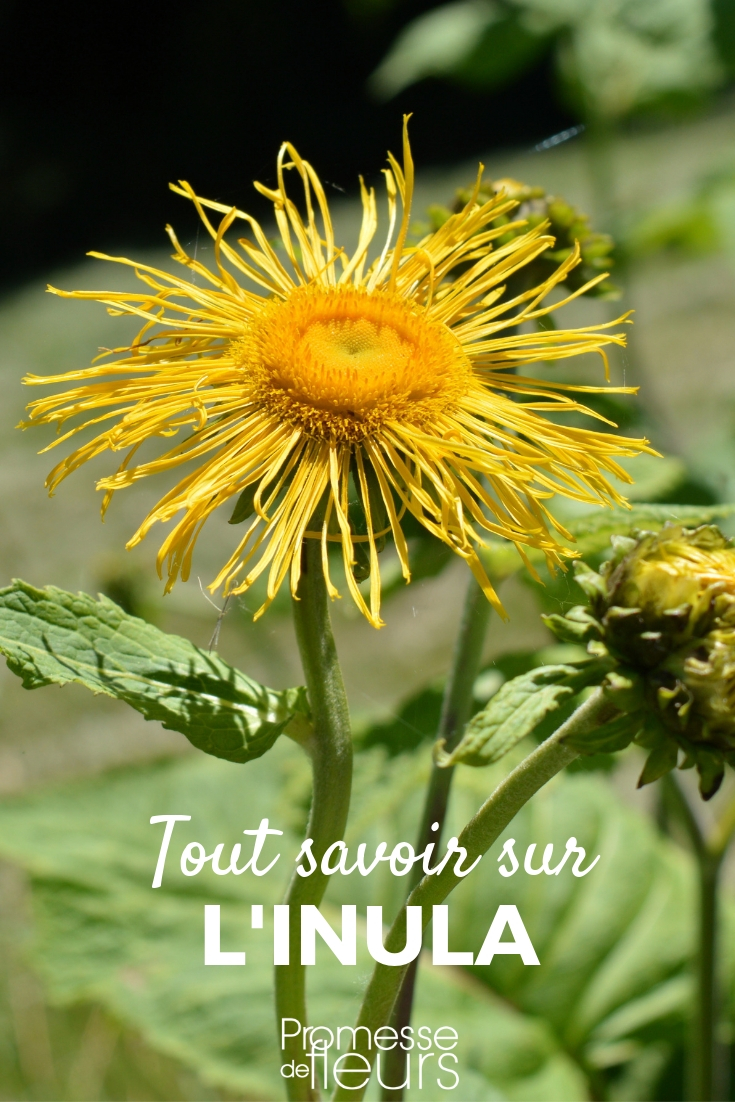































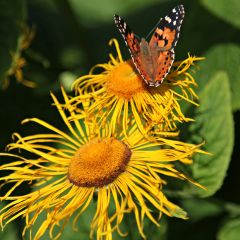



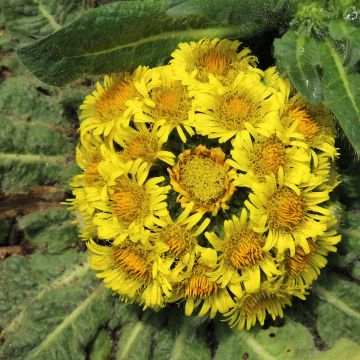
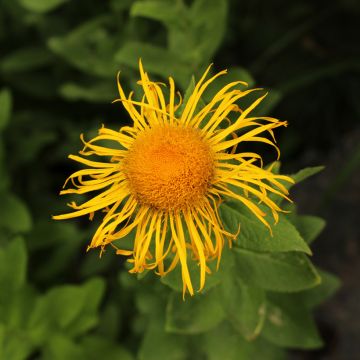
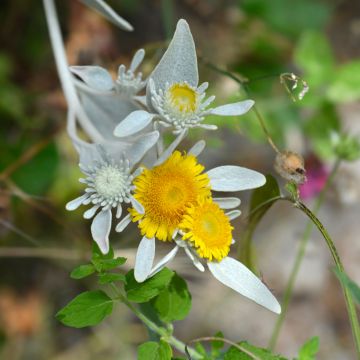

Comments